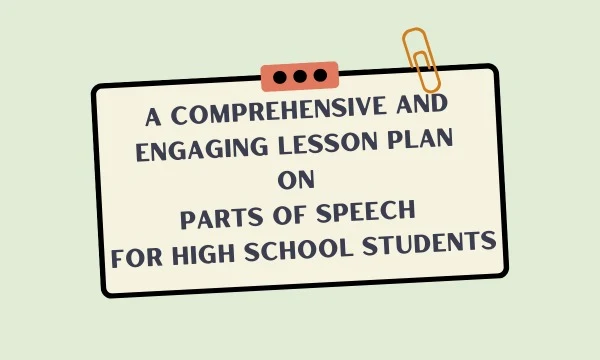A Comprehensive and Engaging Lesson Plan on Parts of Speech for High School Students
Introduction
The parts of speech are the building blocks of language. They are the categories of words that have different functions and meanings in sentences. Knowing the parts of speech can help students improve their grammar, vocabulary, and writing skills. However, many students struggle with identifying and using the parts of speech correctly and effectively. Therefore, this lesson plan aims to provide students with a comprehensive and engaging review of the eight parts of speech: noun, pronoun, verb, adjective, adverb, preposition, conjunction, and interjection. The lesson plan is designed for high school students and is aligned with the Common Core State Standards (CCSS) for English Language Arts and Literacy. The lesson plan includes a variety of activities and assessments that will help students practice and apply their knowledge of the parts of speech in different contexts. By the end of the lesson, students will be able to:
- Identify and use the eight parts of speech in different contexts.
- Explain how parts of speech affect the meaning and structure of sentences.
- Apply their knowledge of parts of speech to analyze and improve their own writing.
Lesson Plan: Parts of Speech
Objectives:
- Students will be able to identify and use the eight parts of speech (noun, pronoun, verb, adjective, adverb, preposition, conjunction, interjection) in different contexts.
- Students will be able to explain how parts of speech affect the meaning and structure of sentences.
- Students will be able to apply their knowledge of parts of speech to analyze and improve their own writing.
Standards:
- CCSS.ELA-LITERACY.L.9-10.1
Demonstrate command of the conventions of standard English grammar and usage when writing or speaking. - CCSS.ELA-LITERACY.L.9-10.1.A
Use parallel structure. - CCSS.ELA-LITERACY.L.9-10.1.B
Use various types of phrases (noun, verb, adjectival, adverbial, participial, prepositional, absolute) and clauses (independent, dependent; noun, relative, adverbial) to convey specific meanings and add variety and interest to writing or presentations.
Materials:
- Parts of Speech Chart
- Parts of Speech Quiz
- Parts of Speech Bingo Cards and Markers
- Parts of Speech Mad Libs
- Parts of Speech Revision Checklist
- Student Writing Samples (from previous assignments or other sources)
Procedure:
- Review the eight parts of speech with the students using the Parts of Speech Chart. Explain the definition, function, and examples of each part of speech. Ask students to provide their own examples and write them on the board or on a poster paper.
- Give each student a copy of the Parts of Speech Quiz. Have them complete it individually or in pairs. Review the answers as a class and clarify any doubts or misconceptions.
- Divide the class into small groups and give each group a set of Parts of Speech Bingo Cards and Markers. Explain the rules of the game: The teacher will call out a word and the students will mark the corresponding part of speech on their bingo cards. The first group to get five in a row (horizontally, vertically, or diagonally) wins. Call out words from different categories (e.g., nouns, verbs, adjectives, etc.) and check the answers with the class after each round.
- Distribute copies of the Parts of Speech Mad Libs to each student or pair of students. Explain that they have to fill in the blanks with words that match the specified part of speech. Have them read their completed stories aloud to the class or to another group and enjoy the humorous results.
- Give each student a copy of the Parts of Speech Revision Checklist and a sample of their own writing or another student’s writing (with permission). Have them use the checklist to identify and correct any errors or weaknesses in their use of parts of speech. Have them rewrite their sentences using different parts of speech to improve clarity, variety, and interest.
- Have students share their revised sentences with the class or with a partner and explain how they changed them and why. Provide feedback and praise for their efforts.
Assessment:
- Formative: Observe students’ participation and understanding during the review, quiz, bingo game, mad libs activity, and revision checklist.
- Summative: Collect students’ revised sentences and evaluate them.

